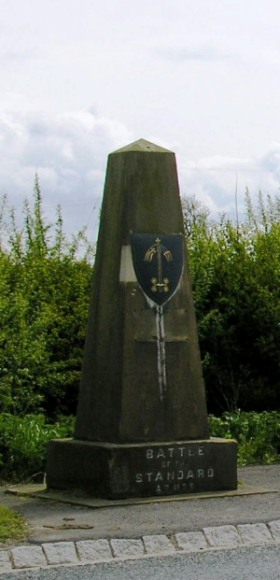History of the Stewarts | Battles and Historic Events
If you are a Stewart Society Member please login above to view all of the items in this section. If you want general information on how to research your ancestors and some helpful links - please look in background information.
If you have a specific question you can contact our archivist.
The Battle of the Standard
Near Northallerton, Yorkshire, England.

The Battle of the Standard
King David I´s sister, Maud, had married Henry I of England, therefore the two monarchs were brothers-in-law and were at peace with one another. Things changed when Henry died in 1135. Civil war broke out in England between Henry´s daughter, Matilda [The Empress Maud] and Steven of Blois, who both claimed the English throne. David I as might have been expected sided with his niece and marched into England against Steven in the spring of 1136, sweeping all before him and capturing every castle in Cumberland and Northumberland, save only Bamborough. A temporary truce was arranged, negotiated by David from a position of strength, but it only lasted a short time before hostilities broke out once more. By this time, Walter Fitzalan had arrived in Scotland and had been made first High Steward. When he set out with David in the spring of 1138 it was the first campaign in which a Stewart bore arms under the Scottish banner.
This was David´s third invasion into England in as many years and it has been described as "the most devastating of all the incursions which ever the Scots made into that country". Steven had gone south to deal with other enemies, so the English barons were led against the Scots by Thurstan, the Archbishop of York.
On a wheeled float he erected a tall mast bearing his standard (hence the name by which the battle is known), hung with banners and holy relics including a consecrated host "so that Jesus Christ might be bodily present as Commander in the battle".
The High Steward, in his first battle, was second-in-command of the right wing, under Prince Henry, the king´s eldest son. They led a successful assault on the English left and drove their enemy from the field. But victory slipped from the Scots and at last the Scots realised that they were not going to defeat Thurstan and his holy standard.
The English army chose the ground, deploying across the Great North Road two miles north of Northallerton, blocking the southward advance of King David I’s Scottish army. David probably was confident in that he had superiority in numbers and may have attempted to advance and strike the English by surprise but, despite the early morning fog, he found the English ready for him. Although outnumbered, the English forces turned back a series of Scottish attacks. The unarmoured and supposedly ‘wild’ Galwegian infantry, who insisted on spearheading the Scottish attack in place of the well armoured knights, fell in large numbers to the English arrow storm. When they did reach the English lines they were generally cut down in hand to hand fighting with the local levies and the well armed and armoured English men at arms.
The English front line was at times hard pressed, but any breach that the enemy forced was rapidly closed. Late in the battle the Scots did mount one successful attack, when Prince Henry’s small detachment of cavalry punched a hole right through the English battle formation. However this opportunity could not be exploited by the infantry that seconded the charge who, just like the Galwegians, were forced to retreat. The retreat soon turned into a rout.
The Scots finally withdrew as part of the terms of the Treaty of Durham in April 1139, when the River Tees was agreed to become the border between Scotland and England, only the castles of Bamborough and Newcastle being retained by the English.

